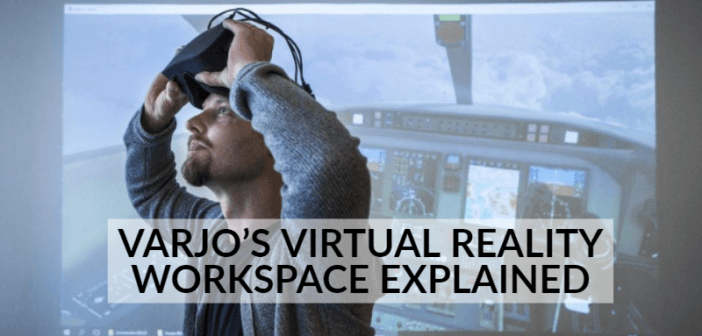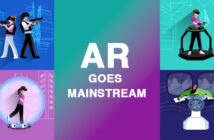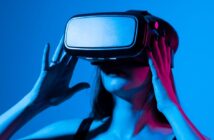The evolution of virtual displays is going to bring ‘personal’ back to computing very soon! Desktops might soon become redundant for engineers and designers as virtual displays become more commonplace.
Experiential computing is something brand new and with leaders of VR and AR like Varjo, we might soon see AR/VR headsets replace traditional computers in the workspace. Here are the Details of Varjo Workspace Demo.
Are you ready to dream about a futuristic, AR-capable, MR workspace?
The new 2D/3D interface by Varjo, popular as Varjo’s Workspace, is a dimensional interface. According to the company representatives, it is compatible with Microsoft Windows. It works with 3D software applications like CAD, which are indispensable parts of designing and engineering.
Varjo Workspace allows the users to switch between virtual, real and mixed reality. It serves VR, AR and MR interfaces according to the user’s demand inside the headset.
For example, a Varjo Workspace user can view the furnishing of a room, and the virtual window that opens as a part of the program/software they are using. The Varjo VR headset allows the user to work on a virtual monitor that floats in the mixed reality space in front, all the while, eliminating the awkwardness of working in virtual 3D environments and then switching back to a 2D interface, like that in Unreal Engine, Unity and 3ds Max.
What is a bionic display and how has Varjo monopolized it?
Last week at CES 2020, Varjo presented its latest AR-capable MR headset alongside the Varjo Workspace concept. The smooth integration of VR along with the preservation of important elements of the real environment reinforces the possibility of replacing workplace monitors and desktops with VR- and AR-capable Varjo XR-1 headsets.
The new AR and VR headset by Varjo has a bionic display just like the other VR headsets from the company. Today, the Finnish XR startup stands apart from the contemporary VR and AR startups due to their exclusive foveated vision. It mimics real human vision, where the objects on the focal plane are the sharpest and those surrounding the focal objects have lower resolution.
Varjo’s bionic display has stolen the spotlight at CES, ever since the introduction of Varjo VR-1 in 2019. It is safe to say that their technology has provided one of the best VR display technologies of the year.
They have achieved it with the help of a novel combination of high-density displays at the centre and lower resolution displays at the peripheral view. Today, Varjo is the only startup that is selling a complete head-mounted device (HMD) with a 60 PPD retina resolution. The qualities of the 60 PPD display closely mimic the limit of the human eye.
What did Varjo present at the 2020 CES that urged designers, engineers, and entrepreneurs to dream about a futuristic AR-inspired workspace?
At the 2020 CES, experts who tried the Varjo Workspace concept headset stated that they could see the real room through the pass-through AR simulation. Varjo’s Workspace Demo is not just about an expansive virtual monitor area, it is about the high-resolution display with complete interactivity.
The Finnish startup has successfully demonstrated how it can bring a window out of a windows device into the user’s real surroundings. Varjo’s new endeavour can pull a 2D image/window and project a 3D view into the AR-inspired workspace with a seamless transition.
Despite the best VR display technology, Varjo is still working on the user interface (UI) of the workspace concept and the form-factor. However, the current quality and user experience (UX) are compelling enough for the technophiles to invest in the dream of a virtual workspace in the near future.
What is unique about Varjo AR-capable XR-1 Headset and the Workspace Concept?
Varjo’s new workspace concept aims to help the workers move between a 2D system and a 3D workspace smoothly without additional equipment. For example, in the 2020 CES demo, the company utilized the example of someone designing the layout of an aircraft cockpit in their demo.
By donning their AR-capable XR-1 headset, the designer could make changes to their cockpit spatial design and press a button to experience the layout first-hand. A single press of a button can transport a person from their work desk to the inside of a cockpit or that of a submarine effortlessly, within a split second.
The designer can experience and test the changes they are making in real-time. it can not only cut down the hours spent in rendering small changes in a large project, but it can also boost the net productivity of the employees. Varjo aims to cut down the endless hours spent in making changes, testing, verifying and then making the second round of changes in these types of design work.
Why is Varjo workspace Concept the future of XR in the Workspace?
Undoubtedly, Varjo workspace Demo is a glimpse of XR in the workplace in the future.
Apart from simulating the traditional 3D workflows, the work inside of the VR concept has other perks like the instant “teleportation” of the designer or engineer from their office to inside their design and back to the office! That makes both designing, construction, and engineering work much more interesting than it currently is today!
After Varjo’s CES stint it is easy for any tech-lover to let their imaginations run wild. However, their UI is still far from perfect. Varjo has to overcome countless frictions in executing elements from 2D to 3D in their workspace concept. Currently, headset ergonomics, headsets in workspace norms, and spatially interconnected software come to mind.
Even with mountains of conundrums and frictions, Varjo Workspace concept does feel like the future of work, especially for the design, and engineering segments.
As the possibilities keep expanding, Varjo Workspace concept might extend to other segments of the industry including medicine, education, adventure sports/tourism, and more. In short, their AR-capable XR-1 headset is about to revolutionize the way we perceive work.
Very soon engineers and designers will shun the traditional 2D displays and the 2D-based 3D designing and rendering software. With technologies akin to Varjo Workspace and AR-capable XR-1 headset, they can directly incorporate designs into a 3D simulated environment while sitting in their workstation.




